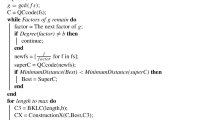Abstract
In this paper, rate 1/p binary systematic quasi-cyclic (QC) codes are constructed based on Matroid Theory (MT). The relationship between the generator matrix and minimum distance d is derived through MT, which is benefit to find numbers of QC codes with large minimum distance by our Matroid search algorithm. More than seventy of QC codes that extend previously published results are presented. Among these codes, there are nine codes whose minimum distance is larger than those of the known codes found by Gulliver et al.
Similar content being viewed by others
References
Shannon C.: A mathematical theory of communication. Bell Syst. Tech. J. 27, 379–423 and 623–656 (1948).
Weldon E.J. Jr.: Long quasi-cyclic codes are good. IEEE Trans. Inf. Theory IT-13(1), 130 (1970)
Townsend R.L., Weldon E.J. Jr.: Self-orthogonal quasi-cyclic codes. IEEE Trans. Inf. Theory IT-13(2), 183–195 (1967)
Karlin M.: New binary coding results by circulants. IEEE Trans. Inf. Theory IT-15(1), 81–92 (1969)
Karlin M.: Decoding of circulant codes. IEEE Trans. Inf. Theory IT-16(6), 797–802 (1970)
Chen C.L., Peterson W.W., Weldon E.J. Jr.: Some results on quasi-cyclic codes. Inf. Control 15, 407–423 (1969)
Hoffner C.W., Reddy S.M.: Circulant bases for cyclic codes. IEEE Trans. Inf. Theory IT-16(4), 511–512 (1970)
Tavares S.E., Bhargava V.K., Shiva S.G.S.: Some rate-p/(p + 1) quasi-cyclic codes. IEEE Trans. Inf. Theory IT-20(1), 133–135 (1974)
Bhargava V.K., Seguin G.E., Stein J.M.: Some (mk, k) cyclic codes in quasi-cyclic form. IEEE Trans. Inf. Theory IT-24(5), 630–632 (1978)
Chen Z.: [Online].(2011), Available: http://www.tec.hkr.se/~chen/research/codes/. Accessed Septemper 2011).
van Tilborg H.C.A.: On quasi-cyclic codes with rate 1/m. IEEE Trans. Inf. Theory IT-24(5), 628–629 (1978)
Gulliver T.A., Bhargava V.K.: Some best rate 1/p and rate (p-1)/p systematic quasi-cyclic codes. IEEE Trans. Inf. Theory IT-37(3), 552–555 (1991)
Gulliver T.A., Bhargava V.K.: Nine good (m-1)/pm quasi-cyclic codes. IEEE Trans. Inf. Theory IT-38(4), 1366–1369 (1992)
Gulliver T.A., Bhargava V.K.: Twelve good rate (m-r)/pm binary quasi-cyclic codes. IEEE Trans. Inf. Theory IT-39(5), 1750–1751 (1993)
Gulliver T.A., Bhargava V.K.: An updated table of rate 1/p binary Quasi-Cyclic codes. Appl. Math. Lett. 8(5), 81–86 (1995)
Chen Z.: Six new binary quasi-cyclic codes. IEEE Trans. Inf. Theory IT-40(5), 1666–1667 (1994)
Chen Z.: On Computer Search for Good Quasi-Cyclic Codes. IEEE Symp. on Information Theory, Norway (1994).
Zhi C.: New results on binary quasi-cyclic codes. Proceeding IEEE Intern. Symp. on Information Theory, ISIT2000, Sorrento, Italy (2000).
Whitney H.: On the abstract properties of linear dependence. Am. J. Math. 57, 509–533 (1935)
Tutte W.T.: Matroids and graphs. Trans. Am. Math. Soc. 90, 527–552 (1959)
Edmonds J., Fulkerson D.R.: Transversals and matroid partition. J. Res. Natl. Bur. Stand. 69B, 147–153 (1965)
Greene C.: Weight enumeration and the geometry of linear codes. Studia Appl. Math. 55, 119–128 (1976)
Geelen J., Gerards B., Whittle G.: Towards a matroid-minor structure theory. In: Grimmett G., McDiarmid C. (eds.) Combinatorics, Complexity and Chance. A Tribute to Dominic Welsh. Oxford University Press (2007).
Ahlswede R., Cai N., Li S.-Y.R., Yeung R.W.: Network information flow. IEEE Trans. Inf. Theory 46, 1204–1216 (2000)
Dougherty R., Freiling C., Zeger K.: Networks, matroids, and non-Shannon information inequalities. IEEE Trans. Inf. Theory 53(6), 1949–1969 (2007)
Feldman J., Wainwright M.J., Karger D.R.: Using linear programming to decode binary linear codes. IEEE Trans. Inf. Theory 51(3), 954–972 (2005)
Barg A.: The matroid of supports of a linear code. Appl. Algebra Eng. Commun. Comput. 8(2), 165–172 (1997)
Oxley J.G.: Matroid Theory. Oxford University Press, Oxford (1992)
Grassl M.: Tables of linear codes and quantum codes. [Online]. Available at http://www.codetables.de. Accessed Septemper 2011.
Author information
Authors and Affiliations
Corresponding author
Additional information
Communicated by J.-L. Kim.
Rights and permissions
About this article
Cite this article
Wu, G., Chang, HC., Wang, L. et al. Constructing rate 1/p systematic binary quasi-cyclic codes based on the matroid theory. Des. Codes Cryptogr. 71, 47–56 (2014). https://doi.org/10.1007/s10623-012-9715-1
Received:
Revised:
Accepted:
Published:
Issue Date:
DOI: https://doi.org/10.1007/s10623-012-9715-1



